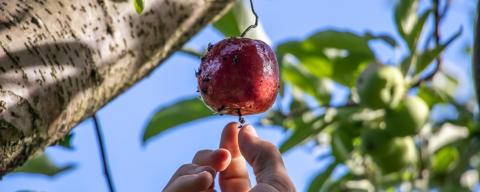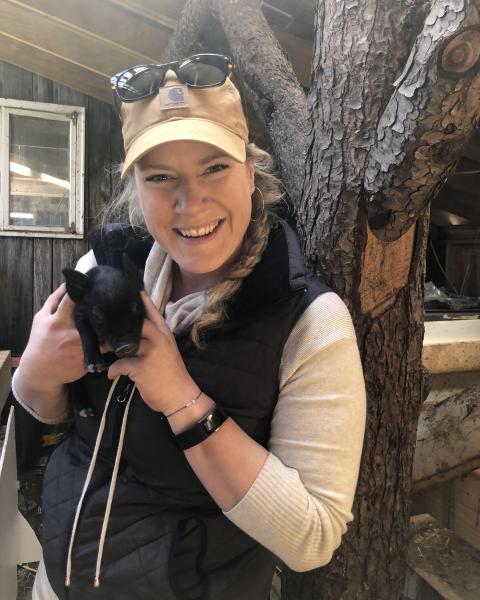7 Social Media Lessons Every NH Farmer Should Know
This spring, farmers from across New Hampshire came together for a six-week Social Media for Farmers course. Hosts Jesse Wright and Marlana Trombley aimed to help farmers confidently navigate Instagram and Facebook—sharing their stories, marketing their products and growing their businesses. Whether they were looking to build confidence online, attract more customers or just feel less frustrated by the whole process, participants left with a new set of tools—and in many cases, a renewed sense of possibility.
We’ve gathered seven of the most practical and impactful lessons shared during the course—insights that any farmer can use in their marketing plan.
Before diving into content strategies, the course began with a basic—but often skipped—step: clarifying your farm’s values and voice. For many farmers, this part can feel like fluff compared to the day-to-day demands of running a business. But taking time to define what makes your farm unique is the foundation for everything that follows on social media.
“I really cannot overstate how helpful and inspirational this course was for me. I dug deep into creating my brand kit, my colors, logos, and fonts, and created templates for carousel posts.” —Beth, Food and Blooms Farm in Derry, NH
Rather than rushing into individual post details, farmers started by thinking about the big picture: who they are, who they serve, and what kind of impression they want to make. While you may know it in your head, writing it down makes it easier to write captions, choose photos, and build consistency across platforms.
Put It into Practice
If you’ve never sat down to articulate your farm’s mission, values, and tone, this is your invitation to do so. It’s not just a marketing exercise; it’s a compass that helps every post, label, and customer interaction feel more intentional.
Most farm businesses on social media get stuck eventually—that moment when you know you should post something, but you’re staring blankly at the screen with no idea what to say. To move past that kind of writer’s block, it helps to ask: Who am I trying to reach?
Instead of trying to appeal to everyone, farmers in the course spent time identifying their best customers—the ones who already get it. We talked about the buyer’s journey using a dating analogy. Most people who see your post are just meeting you—they’re in the awareness stage. Only a few are ready to commit long term (like buying a CSA share). That insight helped farmers realize that not every post needs to make a sale. Sometimes, it’s just about building trust—like a first date.
“The customer journey and the dating analogy is one I will carry with me. I learned a lot about social media theory...this course really did give me a better understanding of how to use Social Media more effectively.” – 2025 Social Media for Farmers Course Participant
Put it into Practice
Clarity about who you’re trying to reach makes posting easier and more effective. Start by visualizing your farm’s ideal customer. Maybe it’s a longtime CSA member who tells all her neighbors about your tomatoes. Give her a name—Sheila—and when you're writing about CSA signups, write to her.
Even if no one named Sheila actually sees your post, focusing your voice and message on someone real (instead of trying to speak to everyone) makes your marketing feel more personal and more persuasive.
Many farmers feel overwhelmed by the pressure to post in real time—especially during the busy season. It’s easy to get stuck thinking, what do I even have to say? Do people care about this?
That’s why we spent time exploring ways to prepare ahead: batching posts in one sitting, building a filing cabinet of reusable images and videos, setting a weekly posting rhythm and using seasonal themes (like planting, harvesting, or first frost) to guide content ideas.
One participant shared how they are recognizing the time it takes to get organized behind the scenes.
“I’ve been doing a lot of work in the background to prepare myself to be able to post regularly and consistently.” – 2025 Social Media for Farmers Course Participant
Put It into Practice
Think of your content like your crop plan, you don’t plant the seeds the same day you want the vegetables. The same goes for photos and videos. Head out this week and take some shots of what’s happening on your farm. Even if you don’t use them today, you’ll be glad you have them next month or next season when things get hectic and you need something to post.
Videos on social media can feel intimidating, especially if you’re used to behind-the-scenes work, not being in front of a camera. But participants found that using tools like Instagram Reels and Facebook Stories helped them reach new people and share the real story of their farms.
These formats are especially effective for showing the energy, beauty and daily rhythm of farm life—whether that’s planting a bed of carrots, making cheese or wrapping bouquets for market.
“I posted a video yesterday on Facebook as a regular video, reel, and on Instagram—and my reel got over 1K views so far! For me this is a huge response! One step at a time, I'm making progress.” —Julie of McGlaflin Farm in Claremont, NH
The big takeaway isn’t about going viral, it’s that real, simple moments on the farm can be powerful.
Put It into Practice
Pick one moment from your day—loading the truck, feeding animals, checking the seedlings—and film a 10-second video on your phone. You don’t need music, editing, or captions (yet). Just try it. You can post it, save it for later, or simply use it as practice. The goal isn’t perfection—it’s consistency and connection.
The course aimed to demystify social media insights like reach, engagement, and audience demographics. We emphasized using just a few key metrics to track progress and test new ideas—no spreadsheets required.
“Using Meta and scheduling posts based on the active times, using more videos, and using carousel pics were all game changers.” – 2025 Social Media for Farmers Course Participant
One important takeaway? Follower count isn’t everything. It’s easy to get hung up on how many followers or likes you have, but that number is often a vanity metric—it looks nice but doesn’t always reflect who’s actually paying attention or engaging with your content. What matters more is when your audience is online, what they engage with, and how they respond so you can replicate it and increase action.
Put It into Practice
Looking at your analytics can help you post at the right time, choose the best content format (like a reel vs. a photo), and understand what topics spark interest. Login to Meta Business Suite and peek at your insights. Meta has done much of the leg work for you and will offer suggestions for best posting times.
One of the biggest mindset shifts was this: you don’t have to do it all or do it alone. Following fellow farmers and joining regional groups can bolster your online community, increase local reach, and make posting feel a little less lonely! Everyone in this course started following each other and many participants left with new ideas for collaboration.
Stacy of Begin Family Farm in Hollis, NH reminded us that collaboration doesn’t have to stop at other farms. “Sharing stuff from other local businesses to your stories (and tagging them) can help build that relationship too. Like the bakery that buys your ingredients and posts a photo of what they made.”
Put It into Practice
Who are you working with in your community that you could collaborate with on social? Getting four fellow farmers’ market vendors together for a single post is a great first step. But don’t stop there, think about your vendors and customers; even other small businesses outside of the agricultural community make great partnerships for posting.
Throughout the class, co-instructor Marlana was in awe of the participating farmers' day-to-day lives. As someone planted firmly outside the agriculture world, her fresh perspective reminded all of us that what feels obvious to farmers can be fascinating to our customers.
“Marlana's ‘outsider’ perspective was helpful. Being in it, you forget what people realistically do or don’t know.” – 2025 Social Media for Farmers Course Participant
This is a great example of what many call the “curse of knowledge”—the idea that once you know something well, it’s hard to remember what it’s like not to know it. That can make it easy to skip over the basics in your marketing, even when that’s exactly what your audience needs.
You don’t have to perfectly curate every post. Sometimes, simply showing how brussels sprouts grow, animals get moved, or what goes into prep for the farmers’ market is the best content to build engagement. Your monotonous task may be the most interesting thing your customers see all day!
A huge thank you to Marlana for helping make this clear—and for the creativity, energy, and expertise she brought to every session. Her insights helped farmers feel empowered, seen, and supported.
Put It into Practice
Find a friend of a friend, someone who doesn’t know your farm and give them a 30 second version of your farm tasks that week. Ask them what parts were interesting or surprising, confusing even. Those are the things to capture and share with your audience!
If you’re thinking about brushing up your social media strategy this season, start with small steps by following the Put It into Practice tips. You don’t need to be an expert to build connections online; you just need to start where you are.
For upcoming marketing education opportunities, check out some of Marlana’s courses through UNH Professional Development & Training. If you’re new to farming and looking for the basics of business and production, head to UNH Extension’s New Farmer Resources Page or sign up for our Annual New Farmer School.
Extension Services & Tools That Help NH Farmers Grow
Newsletters: Choose from our many newsletters for production agriculture
Receive Pest Text Alerts - Text UNHIPM to (866) 645-7010


